|
#1
| |||
| |||
|
Please provide the previous year question papers of MCA 1st Semester of SV University? Hello friend as you want the SV University MCA 1st Semester Question Papers so here I am providing you the same….. First Semester Section-A Answer Any Five questions ( 5 X 4 = 20 ) 1. Give a brief note on historical perspective of computers 2. Write about the BUS Structures 3. Discus about the displacement mode of addressing 4. Write about basic Input / Output operations 5. Discus about the interrupts 6. Discus about the standard Input / Output Interfaces 7. Give a brief note on the following (a) Cache Memory (b) Virtual Memory 8. Write about the addition of positive Numbers 9. Discus about the Execution of a complete Instruction 10. Write about the micro programmed control Section – B Answer Any Five Questions choosing one from each unit. (5 X 10 = 50) Unit – 1 11. Explain the different functional units of a Computer (or) 12. Explain the basic operational concepts of a computer Unit- II 13. Explain about the different addressing modes (or) 14. Explain about instructions and instruction Sequencing Unit-III 15. Explain about Input / Output organisation (or) 16. Explain about DMA Unit – IV 17. Explain about the different types of memories (or) 18. Describe the operations on floating point number Unit – V 19. Describe the basic concepts of pipelining (or) 20. Describe the fundamental concepts of a processing unit FIRST SEMESTER Each Question carries FOUR Marks 5 x 4: 20 1. Show that ~(Pv(~P^Q)) and ~P^~Q are logically equivalent. 2. What is indirect proof of a theorem? 4. What is Recursive Subroutine? 3. Define and explain Strong Mathematical Induction. 5. How many ways 3 integers be selected from the integers 1, 2,…….,30 so that their sum is even? 6. State and Prove Generalized Pigeonhole Principle. 7. Define an Equivalence Relation and give an example of it. 8. Define Join Semi Lattice and 9. How many edges are there in a graph with 10 Vertices each of Degree 6? 10. Explain (a) Eulerian Path (b) Hamilton Path. PART-B Answer any FIVE Questions choosing ONE from each unit. Each Question carries TEN Marks 5 x 10:50 Unit- I 11. Prove or disprove the intersection of two equivalence relation is also an equivalence relation 12. (a) State all Rules for Logical inference. (b) Show that the hypothesis. If you send an email message I will finish writing the program. If you do not send me an email message then I will go to sleep early. If I go to sleep early I will wake up feeling refreshed. Lead to the conclusion if I don’t finish writing the program then I will wake up feeling refreshed. Unit-II 13. Prove that 11 n+2+12 2n+1 is divisible by 133, where n € I+ by Mathematical Induction. 14. Using CP Rule Show that ~Av~C is a valid conclusion from A->B,C->D,( D^B)->E and ~E . Unit-III 15. How many cards must be selected from a standard deck of 52 cards to guarantee that at least 3 cards of the same suit are chosen? How many must be selected to guarantee that at least 3 hearts are selected. 16. Solve the Recurrence Relation a n = 6a n-8a n-2 for n ≥ 2, a 0 =4,a 1 =10 Unit-IV 17. (a) Define Transitive closure of relation. (b) Draw the Hasse diagram for (D 24,1) where D 24 is the set of all divisors of 24 and 1 denotes the operation “divisor of “. 18. Define Finite State Machine and find a Turing Machine that recognizes the set {0 n 1 n / n ≥ 1 }. Unit –V 19. (a) Define 1. Degree 2. Complete Graph 3. Connected Graph 4. Cycle and give an example of each. (b) Show that a connected graph with ‘n’ vertices has at least ‘n-1’ edges. 20. (a) Define a Chromatic number and find the chromatic number of complete graph of ‘n’ vertices k n . (b) Explain Traveling Salesman Problem. FIRST SEMESTER PART-A Answer any 5 questions Each question carries 4 Marks 5X4=20 1 . What is the difference between conventional & object- oriented programming languages? 2. What is the hierarchy of Stream classes? 3. What is Type casting 8: explain its Types? 4. Explain (1) Pass By Value (2)Pass By Address (3)Pass By Reference 5. Explain this pointer, Void pointer, Wild pointer? 6. Describe about pure VIRTUAL Functions 7. What are the merits & demerits ofa FRIEND function? 8. What is difference between class & a structure? How to define a member functions of a class? 9. List out characteristics of Constructor, Destructor? I 0. What is the difference between view & delete operators with simple example? PART -B Answer Any 5 Questions choosing one from each unit Each question carries 4 Marks UNIT —I 5X10=50 1 1 . a) Difference in using C& C++ I/O functions? b) What are member functions of ISTREM class? 12. Explain briefly all Decision Making & Loops in C++? UNIT -II 1 3 . a) Principles and Precautions of Function Overloading? b) Write a program to define Overloaded function to add () for integer & float to Perform the addition? 1 4. Write a program to declare an integer array? Display the contented of array using Pointers? UNIT —III 1 5 . What is Inheritance & Explain the type of Inheritance with Examples? 16. What is OOP & Explain its key concepts of OOP? UNIT- IV 17. a) Describe about friend function with example? b) Write a program to show difference b/n static & non- static member variables? 18. What is overloading? Explain overloading with friend function with example. UNIT- V 19 .a) Describe ruler for collating visual functions. b) Write a program to declare virtual function & execute the same function defined in Base & derived classes. 20. What are the principles of Exception Handling? Explain Exception 1-landling mechanism with example? 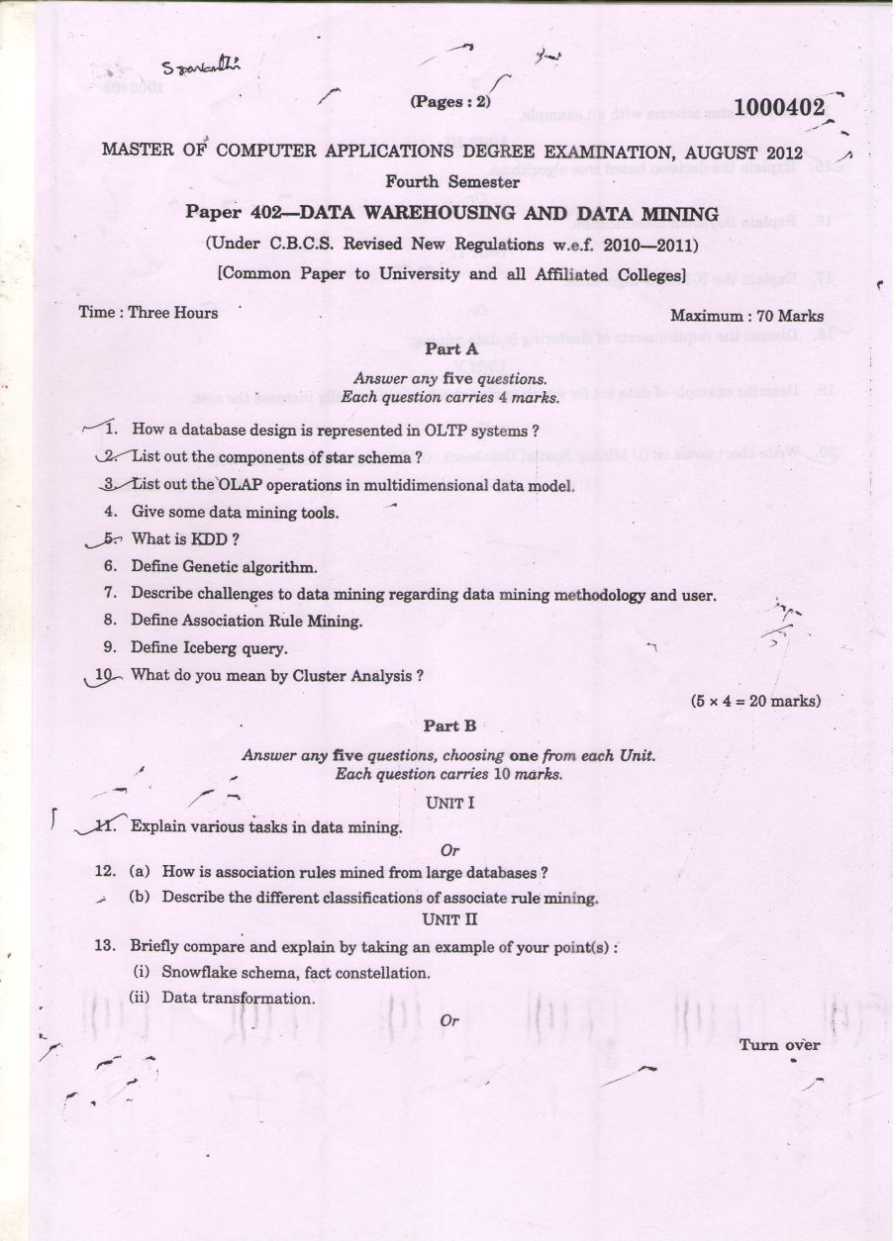 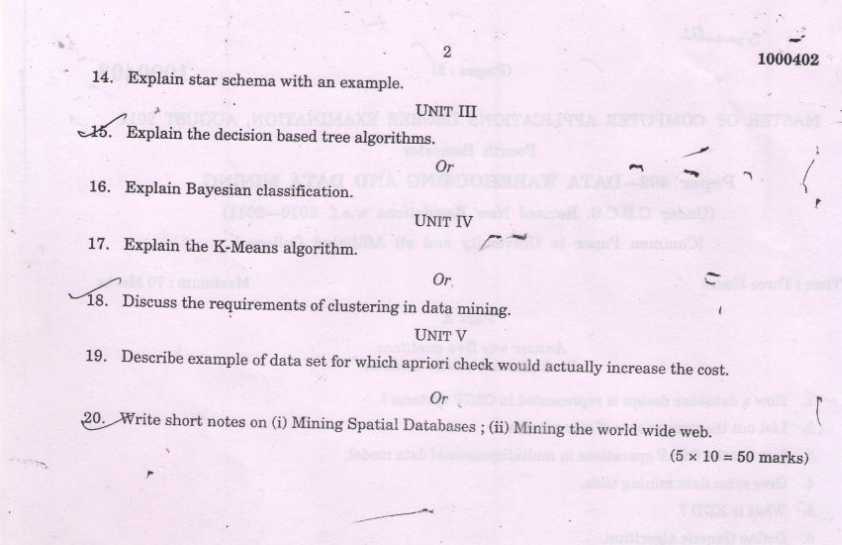 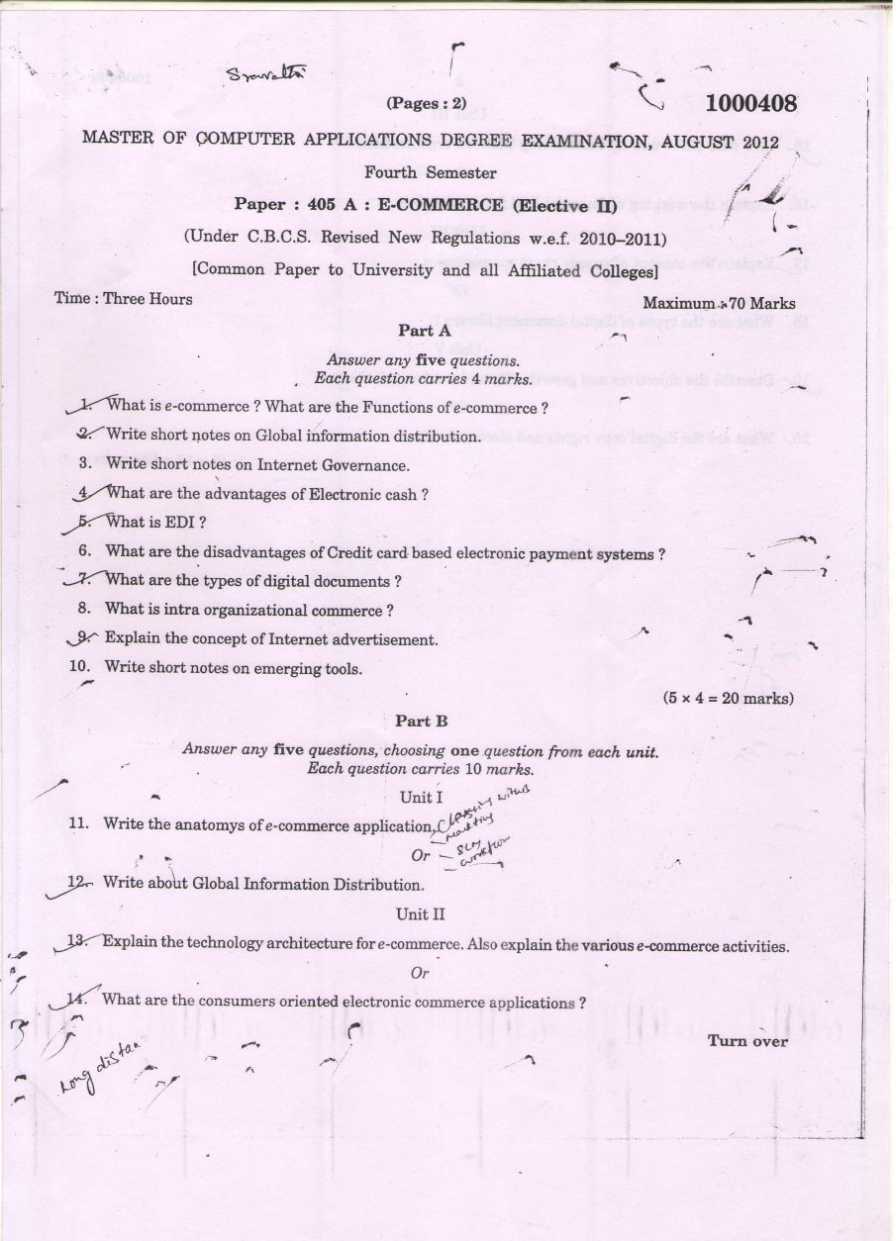  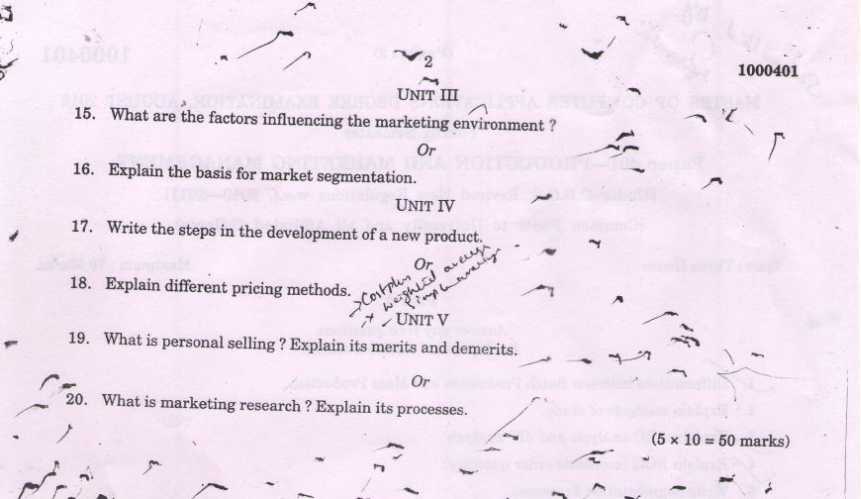 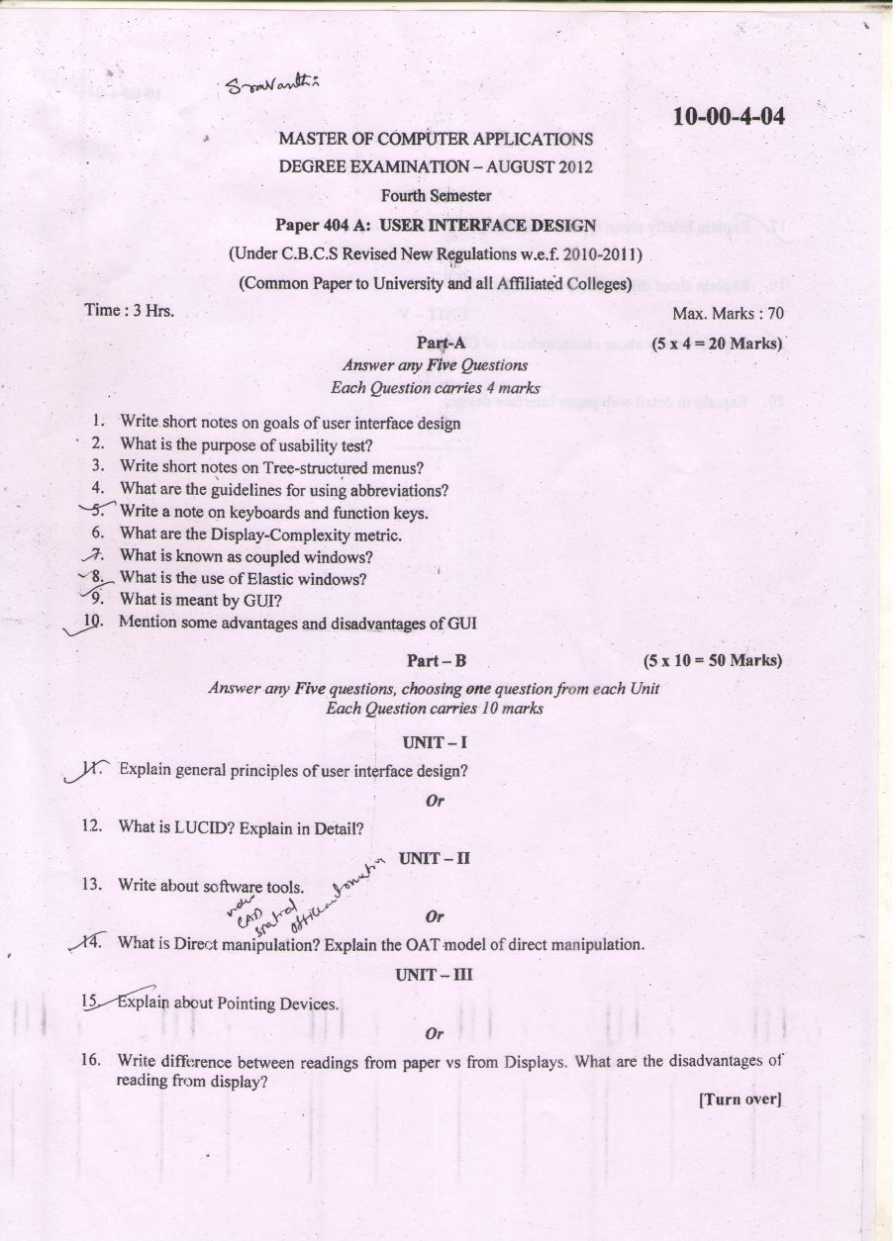 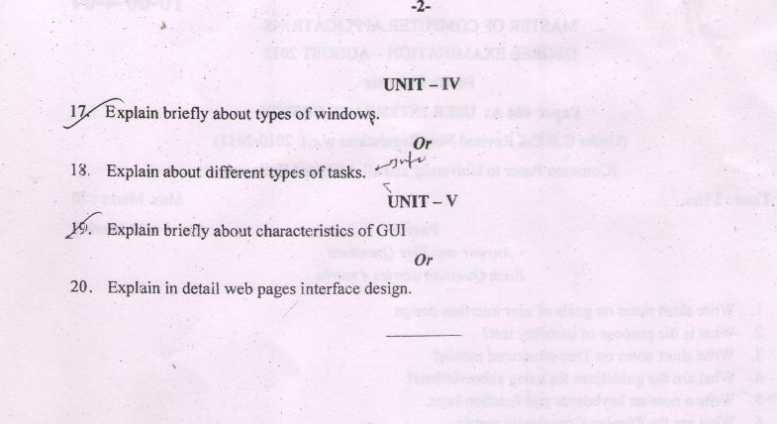 Sri Venkateswara University commonly known as SV University is a reputed educational institute. The Question papers are not available currently. As soon as the papers will be available, I will update them on the site. The syllabus is given below for your help. Syllabus: MASTER OF COMPUTER APPLICATIONS (MCA) SEMESTER I MCA 101: DISCRETE MATHEMATICAL STRUCTURES UNIT I: Logic and Proof, Sets and Functions – Logic Propositional equivalence, Predicates and Quantities, Nested quantifiers, Methods of Proof, sets, set operations, functions. UNIT II: The Integers and Division, Integers and Algorithms, Applications of Number theory, Mathematical reasoning, Induction and Recursion–Proof strategy, Sequences and Summations, Mathematical induction. Recursive definitions and Structural induction, Recursive algorithms, Program correctness. UNIT III: The basics of counting, the pigeonhole principle, Permatations and Combinations, Binomial coefficients, Generalized permutations and combinations, Generating permutations and combinations, Recurrence relations, Solving recurrence relations. UNIT IV: Relations – Relations and their properties, n-ary Relations and their applications, Representing Relations, Closures of relations, Equivalence relations, Partial orderings. Languages and Grammers, Finite state machines with output, Finite state machines with no output, Language recognition, Turing machines. UNIT V: Graphs – Introduction to Graphs, Graph terminology, Representing graphs and Graph isomorphism, Connectivity, Euler and Hamilton Faths, Shortest Path problems, Planar graphs, Graph coloring. Text Book: Rosen K.H. Discrete Mathematics and its Applications, 5th edition, Tata McGraw – Hills, 2003. REFERENCE BOOKS: 1. Johnson Baugh R, and Carman R, Discrete mathematics, 5th edition, Person Education, 2003. 2. Kolman B, Busoy R.C, and Ross S.C, Discrete Mathematical Structures, 5th edition, Pretitice – Hall, 2004. 3. Mott J.L, Kandel A, and Bake T.P, Discrete Mathematics for Computer Scientists & Mathematicians, 2nd edition, Prentice-Hall of India, 2002. 4. Gary Haggard, John Schlipf and sue Whitesides, Discrete Mathematics for Computer Science, Thomson, 2005. MCA 102: PROBABILITY AND STATISTICS UNIT I: Probability: Sample space and events – Probability – The axioms of probability – some elementary theorems – conditional probability – Bayes Theoroem. UNIT II: Random variables – Discrete and continuous – Distribution – Distribution, function. Binomial Poisson and Normal distributions – related properties. UNIT III: Sampling distribution: Population and samples – sampling distributions of mean (Known and unknown) proportions, sums and differences: Point estimation – interval estimation – Bayesian estimation. UNIT IV: Test of hypothesis – mean and proportions – Hypothesis concerning one and two means – Type I and Type II errors. One tail, two-tail tests. Test of significance – students t-test, f-test, x2-test. Estimation of proportions. UNIT V: Curve fitting: The method of least squares – Inferences based on the least squares estimation Curvilinear regression – multiple regressions – correlation for univiarivate and bivariate distributions. TEXT BOOKS: 1. W. Mendenhall, R.J. Beaver and B. M. Beaver, Introduction to Probability and Statistics, Twelfth Edition, Thomson, 2007 2. Erwin Miller and John E. freund. Probability and Statistics for engineers, 6th edition, Pearson EDUCATION/PHI REFERENCE BOOKS: 1. Hogg R V, and Craig A L, Introduction to Mathematical Statistics, American Publishing. 2. Blake I E, An Introduction to Applied Probability, John Wiley. 3. Lipschutz S, Probability (Schaum Series) Mc Graw-Hill. 4. Montgomery D C, Introduction to Statistical Quality Control, Wiley. 5. Montgomery D C, Design and Analysis of Experiments, 5th edition, Wiley, 2000. 6. Grant E.L. and Lcavenworth R.S. Statistical Quality Control 7th edition, Mc Graw – Hill 2003. 7. Dr. Shahnaz Bathul, Text Book of Probability and Statistics, VGS Publishers, 2003. MCA 103: INTRODUCTORY PROGRAMMING UNIT I: Software Overview, Software development process, Introduction to C++, The character set, Data types, Operators, C++ declarations. Input/Output statements, Expression evolution, Assignment statement, Control structures, Pre-processor directives. UNIT II: Functions – Parameter passing Function prototypes, Scope rules: Arrays, Strings, I/O formatting, Files. UNIT III: Basic concepts of Object Oriented Programing – Objects, Classes, Data abstraction, Data encapsulation, Inheritance, Polymorphism, Dynamic binding, Message passing: Object oriented software development – Class diagram, Object diagram, Use case diagram, State chart diagram, Activity diagram. UNIT VI: Classes, and Objects in C++, Constructors, and Destructors, Operator overloading. Type conversions, inheritance. UNIT V: Pointers, Memory management – new, and delete operators, Dynamic objects: Binding, Polymorphism, Virtual functions, Templates, Exception handing. Text Books: 1. Kamthane A.N. Object-oriented Programming with ANSI & Turbo C++ Pearson Education 2003. References Books: 1. Stroustrup B, The C++ Programmin Language, Special Edition, Addison Wesley, 2000. 2. Wang P.S, Standard C++ with Object Oriented Programming, 2nd edition, Thomson Learning, 2001. 3. Booch G, Rumbaugh J, and Jacobson I, The Unified Modeling Language User Guide, Addison Wesley, 1999 (For Unit III) 4. Pohl I, Object-Oriented Programming Using C++ 2nd edition, Addison – Wesley, 1997. 5. Lippman and Lajoie, C++ Primer, 3rd Edition Addison, Wesley, 1998. 6. Deitel and Deitel, C++ How to Program 3rd edition Pearson Education, 2001. 7. Lafore R, Object-Oriented Programming in Turbo C++, Galgotia Publications, 1998. 8. Lawlor S C, The Art of Programming: Computer Science with C++, Thomson Learning, 1998. 9. Chandra B. Object-Oriented Programming in C++, Narosa Publishing House, 2002. 10. Ravichandran D, Programming with C++, Tata MeGraw-Hill, 2003. MCA 104: COMPUTER ORGANIZATION UNIT I: Logic Circuits: Logic functions – synthesis of logic functions – Minimizations of logic - Synthesis with NAND and NOR gates Implementation of Logic gates - Flip-flops – Registers and shift registers – counters – decoders – Multiplexesrs – PLDs – sequential circuits. Basic Structure of Computers: Functional Units - Basic operational concepts – Bus structures – performance – Multiprocewessors and Multi computers: Functional Units – Basic operational concepts – Bus structures – performance – Multiprocessors and Multicomputers – Historical Perspective. UNIT II: Machine Instructions and programs: Numbers, Arithmetic operations and characters – Memory locations and address, operations – instructions and instruction, sequencing – addressing modes - assembly language – basic input/output operations – subroutines – encoding of Machine instructions. Instructions – Assembly language –O/I operations – Registers and addressing – Instructions language – program flow control – I/O operations logic instructions of 6300 and Intel Pentium. UNIT III: Input / Output organization: accessing I/O Devices – Interrupts – direct memory access – buses 240-interface circuits – Standard I/O Interfaces. UNIT IV: Memory System, Concepts – semiconductor RAM memories - Resdonly memories – cache memories – performance considerations – virtual memories management requirements – secondary storage Arithmetic: Addition and subtraction of signel members – design of fast adders – multiplication of positive members – signed operand multiplication – fast multiplication – integer division – floating point numbers and operations. UNIT V: Basic Processing Unit: Concepts – execution of a complete instruction – Multiple – Bus organization – hardware control – microprogrammed control. Pipelining: Concepts – Data hazards – instruction hazards – influence on Instruction sets - data path and control constructions – supers cal operation- ultra SPARC II – Performance considerations. Text Books: Hamacher C, Vranesic Z, and Zaky S. Computer Organization, 5th edition, Mc Graw – Hill, 2002. Reference Books: 1. Stallings W, Computer Organization and Architecture, 6th edition. Parson Education, 2003. 2. Mano M.M. Computer System Architecture, 3rd edition. PHI, 1993. 3. Yarbrough JM, Digital Logic – Applications and Design, Thomas Lernig, 1997. 4. Heuring VP, and Jordan HF, Computer Systems Design and Architecture, Pearson Education, 1997. MCA 105: ORGANIZATION AND MANAGEMENT UNIT I : Fundamentals of Management – Management Thought- The Concept, Nature of And Process of planning – Objectives of Business – Instrument of Planning. UNIT II: Decision Making – Organisation and organization Structures – process of organizing – Departmentation – Line – staff and lateral relations. UNIT III: Delegation and decentralization – Directing and problems in Human relations – Motivation UNIT IV: Communication – Leadership –Coordination – Management control – Control techniques. UNIT V: Dynamic Personnel Management – staffing policies and process – wage and salary administration. Text Book: 1. Agarwal R D, “Organisation and Management”. Tata Mc Graw – Hill publishing Company Limited, New Delhi. 2. Kootz H, and Weihrich H, Essentials of Management, 5th edition, Tata Mc Graw – Hill, 1998. 3. Biswajeet Pattanayak, Human Resource management – Prentice – Hall India Private Ltd, New Delhi, 2001. 4. Aswathappa K., Human Resource and Personnel Management, Text and Cases, 3rd edition, Tata Mc Graw – Hill Publishing Company Ltd., New Delhi, 2004. Reference Books: 1. Mirza S Saiyadain Human Resource Management, 3rd edition, Tata Mc Graw Hill, New Delhi, 2003. 2. Weihrich H, and Koontz H, Management – A Global Perspective, 10th edition, Mc Graw – Hill, 1994. 3. Robbins SP. And DeCenzo D, Fundamentals of Management, 4th edition, Prentice Hall, 2003. 4. Dessler G, Management: Principles and Practices for Tomorrow’s Leaders, 3rd Edition, Prentic Hall, 2003. 5. Chandan J S, Management Concepts and Strategies, Vikas Publishing House, 2002. 6. Ivencevich. John M., Human Resource Management 9th edition, Tata McGraw Hill, New Delhi, 2003. 7. Decenzo David, A., Robins Stephon P., Human Resource Management, 7th Edition, John Wiley & Sons (Asia) Pte. Ltd, Singapore 2002. 8. Dessler Gary Human Resource Management, 8th edition, Pearson Education, New Delhi, 2002. For more detailed syllabus click on the attachment Last edited by Aakashd; December 23rd, 2019 at 09:31 PM. |